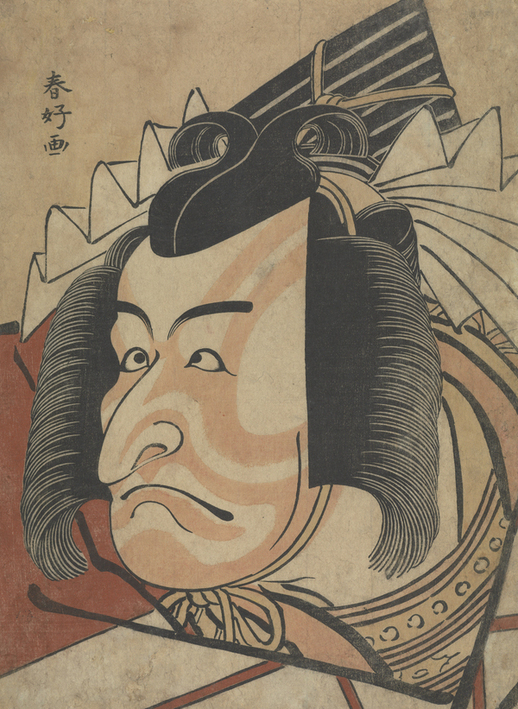2025.05.29
白洲信哉の「多様なるジャパン」「多様なるジャパン」第7回 万国博覧会と浮世絵
白洲信哉=文筆家、日本伝統文化検定協会副会長

勝川春好の大首絵「五代目市川團十郎」
世界各国が参加し、技術や芸術の粋を公開する国際的な博覧会、万博が先月大阪で始まった。1851年ロンドン・ハイドパークにて最初の万国博が行われたというから、賛否はさておき近代オリンピック(1896年)より歴史ある国際的イベントなのだ。わが国初参加は1867年パリ博。漆器に陶器など伝統工芸品が展示され、世に知られた「ジャポニスム」は万博を介し広まったのだ。中でも浮世絵は、19世紀中頃から増加した外交官らが持ち帰り、例えば英国公使が収集したそれが、これに先立つロンドン万博(1862年)に出品されるなど、浮世絵ブームは最高潮を迎える。モネにルノワールやドガ、かのファン・ゴッホは浮世絵500枚を所有し、印象派を中心とした近代絵画に影響を与えていく。
芸術の都パリでは、鎖国していた日本は「大いなる神秘」であった。日本館では檜(ひのき)造りの日本家屋で、髪を結い振り袖姿でお茶を振る舞い、「動く浮世絵」と大人気だったというが、単に異国情緒の珍しいモチーフだけが画家たちに称賛されたのではない。非対称や多様な色使いに一部を切り取ったデザイン性あふれた遊び心に惹(ひ)かれたのだ。この連載第3回の「唐物と高麗茶碗」で書いた不完全なモノへの美意識や、台子茶から四畳半そして二畳台目まで引き算を重ね洗練されたのと同様、大胆に役者の顔だけに焦点を当てた「大首絵」に北斎の「浪」など浮世絵は切り捨ての美学満載だ。
その今風でいうインフルエンサーとして登場したのが、1878年同じくパリ博に渡仏した林忠正だった。時に26歳、流ちょうなフランス語で浮世絵や日本史を解説しジャポニザン(日本美術愛好家)のよき相談相手となり、大量の浮世絵版画を輸出、たちまち大商人として成功を収めた。だが、忠正は単なる商人ではなく1900年5回目のパリ博事務官長に就任すると、国宝級の美術品にとどまらず、帰国して明治天皇に御物の出品を懇願、約800点の古美術を展示する。
「万博は国家間の競争であり、一国の文明度を競う平和な戦いだ」。林の言葉だが、一昨年オークションでレコードを更新(276万ドル)しパスポートや新札にも刷られた北斎「神奈川沖浪裏」が変わらずの人気だが、僕らの伝統文化を俯瞰(ふかん)し海外に説明できる今忠正の登場に期待したい。古美術の役割は文化大使の側面もあるのだ。会場は法隆寺金堂をモデルに、展示を見た当時フランスの外務大臣は「人々にぜひ日本古美術館を観覧されるように勧めたい。1000年前、ヨーロッパがまだほとんど原始の時代に、日本はすでに独特の美術をつくりあげ、その力量も優秀であった」と新聞記者に語った。
Diverse Japan, Vol. 7: World Expositions and Ukiyo-e
Shinya Shirasu = writer, vice-president of the Japanese Traditional Culture Certification Association

Katsukawa shunko's large head painting “Ichikawa Danjuro V”.
The first World Expo was held in London's Hyde Park in 1851, so whether you agree or not, it is an international event with a longer history than the modern Olympics (1896). Japan's first participation was at the Paris Exposition of 1867. Traditional crafts such as lacquerware and ceramics were exhibited, and “Japonisme”, as it became known to the public, spread through the Expo. Ukiyo-e, in particular, were brought back by the growing number of diplomats from the mid-19th century, and the ukiyo-e boom reached its peak when, for example, a British minister's collection was exhibited at the preceding Expo in London (1862). Monet, Renoir, Degas and van Gogh owned 500 ukiyo-e prints, which influenced modern painting, particularly Impressionism.
In Paris, the capital of art, Japan, which had been closed off from the rest of the world, was a “great mystery”. The Japanese pavilion in the Japanese-style house made of hinoki cypress, where the artists tied their hair and served tea in furisode sleeves, was very popular as a “moving Ukiyo-e”, but it was not just the unusual exotic motifs that were admired by the painters. They were attracted by the asymmetry, the diverse use of colour and the playful sense of design in which parts of the work were cut out. In the same way that the aesthetic sense for imperfect objects, which I wrote about in the third article in this series, “Karamono and Korai Tea Bowls”, was refined through repeated subtraction, from the Daiko tea ceremony to the four-tatami mats and the two-tatami mats dais, Ukiyo-e is full of aesthetic truncation, including “Okushi-e”, which boldly focuses on actors' faces only, and Hokusai's “Nani”.
One of the influencers of this style was Hayashi Tadamasa, who also went to France for the Paris Exposition in 1878. Aged 26 at the time, he explained Ukiyo-e and Japanese history in fluent French, became a good adviser to Japonaissants (lovers of Japanese art), exported large quantities of Ukiyo-e prints, and quickly became a successful merchant. However, Tadamasa was more than just a merchant: in 1900, when he was appointed Secretary-General of the fifth Paris Exposition, he not only exhibited national treasures, but also returned to Japan and begged the Meiji Emperor to allow him to exhibit some 800 antique works of art.
The Expo is a competition between nations, a peaceful battle for a country's degree of civilisation," Hayashi said. In Hayashi's words, Hokusai's Kanagawa Okinamiura, which set a new record (US$2.76 million) at auction the year before last and was printed on passports and new notes, remains popular, but we look forward to the arrival of Tadamasa Kon, who can explain our traditional culture to overseas audiences from a bird's eye view. The role of antiquities is also that of cultural ambassadors. The exhibition was modelled on the Golden Hall of Houryuu-ji Temple, and the then French Foreign Minister, who saw the exhibition, told a newspaper reporter: "I would like to encourage people to visit the Japanese antiquities museum: a thousand years ago, when Europe was still almost primitive, Japan had already created a unique art form and was highly competent at it.
カテゴリー: 白洲信哉の「多様なるジャパン」
関連タグ: #美術





